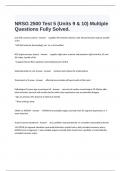NRSG 2500 Test 5 (Units 9 & 10) Multiple
Questions Fully Solved.
LCA (left coronary artery) - Answer -supplies left ventricle anterior wall, intraventricular septum, bundle
of his
*LAD (left anterior descending); circ. or cx (circumflex)
RCA (right coronary artery) - Answer -supplies right atria, anterior and posterior right ventricle, SA and
AV nodes, bundle of his
*marginal branch RCA; posterior descending branch of RCA
Subendocardial or non-Q wave - Answer -involves layer below the endocardium
Transmural or Q-wave - Answer -affected area includes all layers/walls of the heart
Pathological Q wave sign on previous MI - Answer -necrosis of cardiac muscle begins 20-30mins after
total occlusion; necrosis will usually stay but with early reperfusion may occasionally disapper
*sign on previous MI; absence of electrical activity
**they rarely go away
STEMI vs. NSTEMI - Answer *NSTEMI and unstable angina can both have ST segment depression or t-
wave inversion
Acute Coronary Syndrome - Answer -any condition characterized by s/s of sudden myocardial ischemia
-MI-STEMI (st segment elevation myocardial infarction) results from a fully occluded coronary artery;
NSTEMI (non st segment...) and unstable angina normally both result from a partially or intermittently
occluded coronary artery
, Acute Myocardial Infarction (MI) - Answer -death of the myocardial tissue as a result of insufficient
oxygen supplied to the tissue
-typical clinical manifestations-chest pain, dyspnea/SOB, N, V, diaphoresis
-atypical clinical manifestations
*diabetics-may not experience any pain or discomfort
*elderly-jaw pain, fainting, no pain
*females-chest discomfort in neck, back, arm, shoulder, jaw, or throat; SOB, N, V, indigestion
UNRELIEVED with antacids, upper abd pain, dyspnea, fatigue, diaphoresis, dizziness, fainting
-diagnostic studies-12 lead ECG, labs, echocardiogram, exercise stress test (EST)
Anterior (lateral) MI - Answer -look for ST segment elevation in the leads listed (don't need to know?)
Inferior MI - Answer -look for ST segment elevation in the leads listed
*40-50% of all MI's are inferior wall. More favorable prognosis than anterior wall MI
Serum Enzymes and Isoenzymes - Answer -CPK, Troponin, LDH
-other labs-PT/INR, PTT, CBC, BMP, CMP
CPK - Answer -creatine phosphokinase
-in the past, was one of the most sensitive and reliable indicators of all cardiac enzymes in diagnosing an
MI. 50% of CK-MBs rise in the 2-3 hrs after onset of chest pain, peaks in 24hrs, and returns to normal in
next 24-40hrs
*CK-MB--measures damage to heart muscle tissue
*CK-BB--measures damage to brain tissue
*CK-MM--measures damage to skeletal muscle tissues
Troponin - Answer -a protein released by damaged myocardial cells. More sensitive than CK-MB
*Troponin I-rises in 3hrs after an MI, peaks at 14-18hrs, returns to normal in 5-7 days, IS NOT affected by
skeletal muscle damage or kidney disease
*Troponin T-may be present 21 days after an MI, but is sensitive to skeletal muscle damage and kidney
disease




